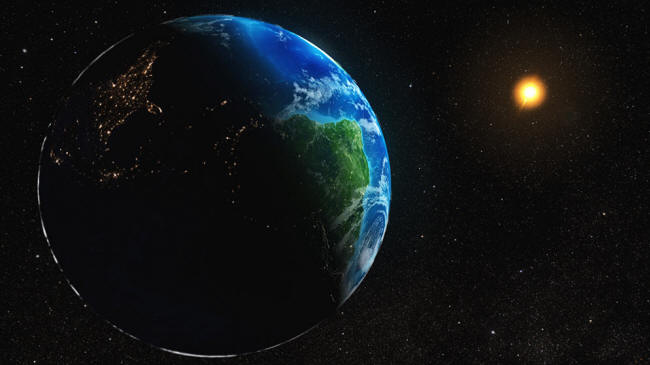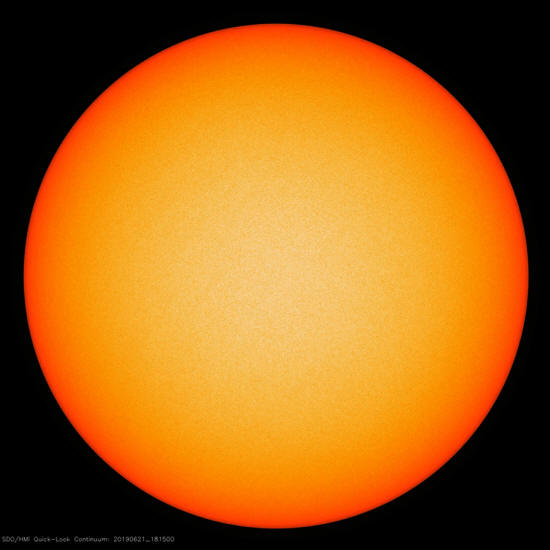|
June 21, 2019
from
Off-Guardian
Website
Since Climate Change (CC) has been a constant of life on Gaia with the evolution of photosynthesis 3.2 billion years ago and has more complexities than this one essay can address.
Ergo, this article will explore CO2 historic contribution to global warming (GW) as well as explore the relationship of Solar Minimum (SM) to Earth's climate.
Even before the UN-initiated Intergovernmental Panel on Climate Change (IPCC) formed in 1988, the common assumption was that carbon dioxide was the key greenhouse gas and that its increases were the driving force solely responsible for rising climate temperatures.
At that time, anthropogenic (human caused) GW was declared to be the existential crisis of our time, that the science was settled and that we, as a civilization, were running out of time.
And yet, in the intervening years, uncertainty remained about GW's real time impacts which may be rooted in the fact that many of IPCC's essential climate forecasts of consequence have not materialized as predicted.
Even as the staid The Economist magazine recently noted:
Before the IPCC formed, NOAA's Mauna Loa Observatory in Hawaii registered CO2 levels at under 350 ppm (parts per million) with the explicit warning that if CO2 exceeded that number, Mother Earth was in Big Trouble - and there would be no turning back for humanity.
Those alarm bells continue today as CO2 levels have risen to 414 ppm as temperatures peaked in 1998.
From the outset, the IPCC controlled the debate by limiting its charter…
In other words, before any of the science had been done, the IPCC's assumption was that man-made activity was responsible and that Nature was not an active participant in a process within its own sphere of interest.
As an interdisciplinary topic of multiple diversity, the IPCC is not an authority on all the disciplines of science within the CC domain.
While there is no dispute among scientists that the Sun and its cyclical output is the true external force driving Earth's energy and climate system as part of a Sun-centered Universe, the IPCC's exclusion of the Sun from its consideration can only be seen as a deliberate thwarting of a basic fundamental law of science, a process which assures a free inquiry based on reason and evidence.
It is the Sun which all planets of the solar system orbit around, that has the strongest gravitational pull in the solar system, is the heaviest of all celestial bodies and its sunspots in relation to Earth's temperatures has been known since Galileo began drawing sunspots in 1613.
Yet the IPCC which touts a 'scientific view of climate change' would have us believe the Sun is irrelevant and immaterial to the IPCC's world view and Earth's climate; hardly a blip on their radar.
In the GW debate, CO2 is dismissed as a colorless, odorless pollutant that gets little credit as a critical component for its contribution to life on the planet as photosynthesis does not happen without CO2.
A constant presence in Earth's atmosphere since the production of oxygen, all living organisms depend on CO2 for its existence.
As a net contributor to agriculture, plants absorb CO2 as they release oxygen into the atmosphere that we two- and four-leggeds depend on for sustenance and oxygen as necessities for survival on Earth.
There are scientists who believe that Earth has been in a CO2 'famine' while others applaud Earth's higher CO2 levels in the last three decades as a regreening of the planet.
While An Inconvenient Truth (2006) and An Inconvenient Sequel - Truth to Power (2016) stage managed the climate question as a thoroughly politicized 'settled science' with former veep Al Gore declaring the drama a 'moral' issue, there is no room for any preference that does not depend on a rigorous, skeptical, independent investigation based on evidentiary facts rather than the partisan politics of emotion and subjective opinion.
Given the prevalence of weather in our daily lives, it would seem elementary for engaged citizens and budding paleo-climatologists to understand Earth's ancient climate history and atmosphere in order to gain an informed perspective on Earth's current and future climate.
As a complicated non-linear system, climate is a variable composition of rhythmic spontaneity with erratic and even chaotic fluctuations making weather predictions near-impossible.
Climate is an average of weather systems over an established long term period while individual weather events indicative of a short term trend are not accurate forecasts of CC.
While ice core readings provide information, they do not show causation of GW but only measure the ratio between CO2 and rising temperatures. It is up to scientists to interpret the results.
And that's where this narrative takes, like ancient weather and climate patterns, an unpredictable turn.
It might be called an inconvenient truth that 'skeptic' scientists have known for the last twenty years that the Vostok ice core samples refute CO2's role as a negative and even question its contribution as the major greenhouse gas.
It is no secret to many climate professionals that water vapor with CO2 at 3.6%.
Located at the center of the Antarctica ice sheet, the Vostok Research Center is a collaborative effort where Russian and French scientists collected undisturbed ice core data in the 1990s to measure the historic presence of carbon dioxide levels.
The Vostok samples provided the first irrefutable evidence of Earth's climate history for 420,000 year including the existence of four previous glacial and interglacial periods.
Those samples ultimately challenged the earlier premise of CO2's predominant role and that carbon dioxide was not the climate culprit once thought. It is fair to add that IPCC related scientists believe Vostok to be 'outliers' in the GW debate.
The single most significant revelation of the ice core studies has been that GW could not be solely attributed to CO2 since carbon dioxide increases occurred after temperature increases and that an extensive 'lag' time exists between the two.
Logic and clear thinking demands that cause (CO2) precedes the effect (increased temps) is in direct contradiction to the assertion that carbon dioxide has been responsible for pushing higher global temperatures. Just as today's 414 ppm precedes current temps which remain within the range of normal variability.
Numerous peer-reviewed studies confirmed that CO2 lags behind temperature increases, originally by as much as 800 years.
That figure was later increased to 8,000 years and by 2017 the lag time between CO2 and temperature had been identified as 14,000 years. As if a puzzlement from the Quantum world, it is accepted that CO2 and temperatures are correlated as they rise and fall together, yet are separated by a lag time of thousands of years.
What is obscure from public awareness in the GW shuffle is that geologic records have identified CC as a naturally occurring cycle with glacial periods of 100,000 year intervals that are interrupted by brief, warming interglacial periods lasting 15,000-20,000 years.
Those interglacial periods act as a temperate respite from what is the world's natural normal Ice Age environment. Within those glacial and interglacial periods are cyclical subsets of global cooling and warming just as today's interglacial warm period began at the end of the Pleistocene Ice Age about 12,000 years ago.
Since climate is not a constant, check these recent examples of Earth's climate subsets:
In addition, climate records have shown that peak CO2 temperatures from the past are relative to today's CO2 level without the addition of a fossil fuel contribution.
For instance, just as today's measurement at 414 ppm contains a 'base' CO2 level of approximately 300 ppm as recorded in the 19th century, any CO2 accumulation over 300 ppm would be considered anthropogenic (man-made) and be portrayed as "historic" or 'alarmingly high' and yet remain statistically insignificant compared to historic CO2 norms.
During the last 600 million years, only the Carboniferous period and today's Holocene Epoch each witnessed CO2 levels at less than 400 ppm.
During the Early Carboniferous Period, CO2 was at 1500 ppm with average temperatures comparable to 20 C; 68 F before diving to 350 ppm during the Mid Carboniferous period with a reduced temperature of 12 C;54F. In other words, current man-made contributions to CO2 are less than what has been determined to be significant.
Contrary to the IPCC's stated goal, NASA recognizes that,
A Solar Minimum (SM) is a periodic 11 year solar cycle normally manifesting a weak magnetic field with increased radiation and cosmic rays while exhibiting decreased sunspot activity that, in turn, decreases planetary temperatures.
Today's solar cycle is referred to as the Grand Minimum which, according to NOAA, predicts reductions from the typical 140 - 220 sunspots per solar cycle to 95 - 130 sunspots.
As the Sun is entering "one of the deepest Solar Minima of the Space Age," a NASA scientist predicted a SM that could "set a Space Age record for cold" but has recently clarified his statement as it applies only to the Thermosphere.
In October 2018, NOAA predicted "Winter Outlook favors Warmer Temperature for much of the US," as above-normal precipitation and record freezing temperatures were experienced throughout the country.
As of this writing, with the Sun noticeably intense, Earth has experienced 22 consecutive days without sunspots for a 2019 total of 95 spotless days at 59%.
In 2018, 221 days were spotless at 61%. Spaceweather.com monitors sunspot (in)activity.
With the usual IPCC and Non-IPCC split, the SM is expected to be at its lowest by 2020 with a peak between 2023 and 2026 as it exhibits
...or it may all be a walk in the park with shirt sleeves in January.
While there is clearly an important climate shift occurring even as the role of CO2 and human activity as responsible entities remains problematic, the elimination of CO2 and its methane sidekick would be exceedingly beneficial for a healthy planet.
It is time to allow scientists to be scientists without political agendas or bureaucratic interference as the Sun and Mother Earth continue in their orbit as they have for eons of millennia.
As Earth's evolutionary climate cycles observe the Universal law of the natural world, the Zero Point Field, which produces an inexhaustible source of 'free' energy that Nikola Tesla spoke of, is the means by which inter stellar vehicles travel through time/space.
The challenge for ingenious, motivated Earthlings is to harness and extract the ZPF proclaiming a new planetary age of technological innovation with,
...that
it Looks Like a Billiard Ball from SpaceWeatherArchive Website
The sun on June 21, 2019. Credit: NASA's Solar Dynamics Observatory
No sunspots have appeared for the past 34+ days, giving the sun the appearance of a giant orange billiard ball. This is a sign that Solar Minimum is underway...
Earlier this year, a panel of experts from NOAA and NASA predicted that the solar cycle would reach its nadir sometime between July 2019 and Sept 2020.
The current stretch of
spotless suns is consistent with their forecast.
For one thing, solar flares stop happening.
Sunspots are sources of extreme ultraviolet radiation (EUV). Without sunspots, EUV levels decrease, causing Earth's upper atmosphere to cool and contract.
Satellites and space junk
stay in orbit longer as aerodynamic drag subsides.
Indeed, recent high altitude balloon flights show increased radiation in Earth's atmosphere.
Extra cosmic rays,
Solar Minimum won't last forever.
Forecasters expect
sunspot numbers to increase after 2019-2020, climaxing in a new
Solar Maximum around 2023-2026...
|



